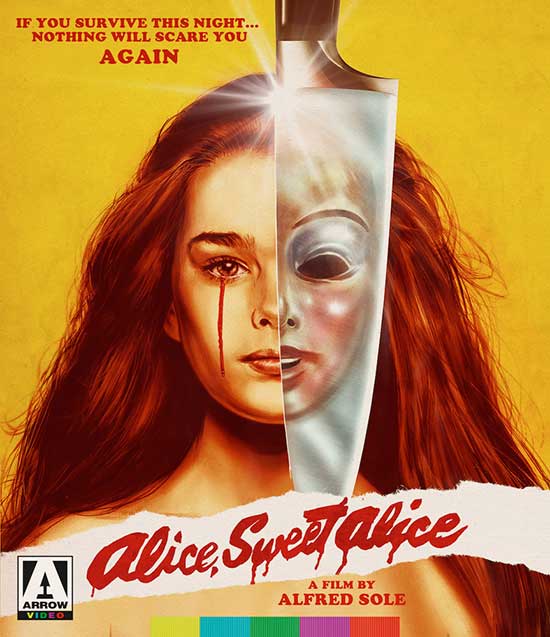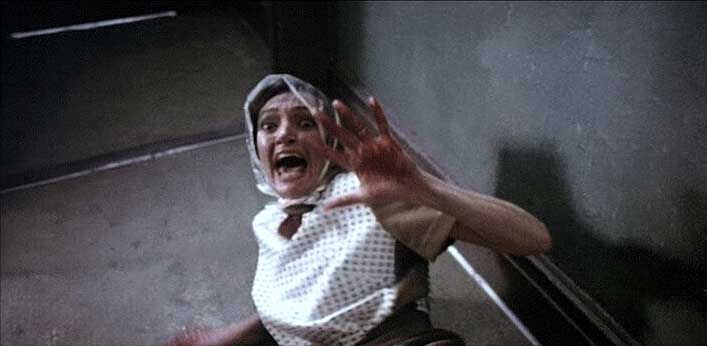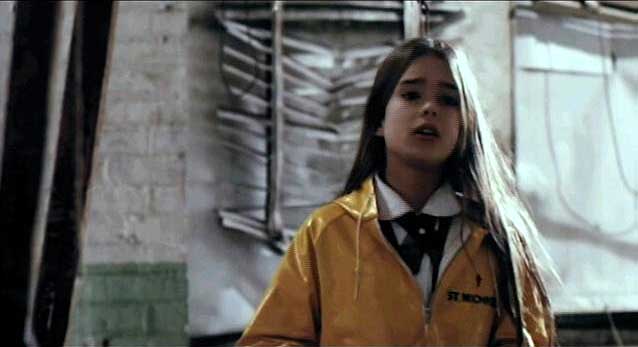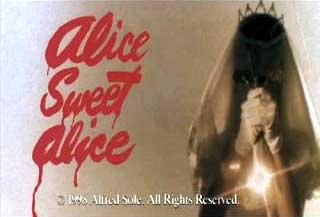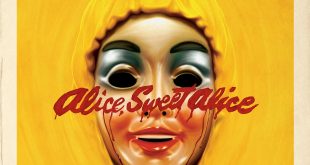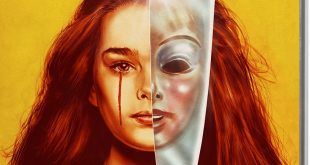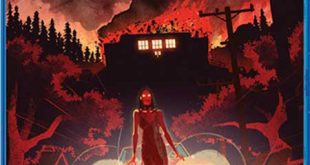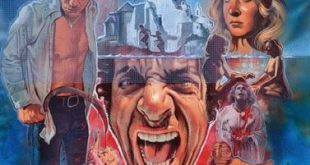SYNOPSIS:
“Alice Spages is a withdrawn twelve-year-old girl who lives with her mother, Catherine, and her younger sister, Karen. Karen gets most of the attention from her mother, and Alice is often left out of the spotlight. But when Karen is found brutally murdered in a church before her first holy communion, all suspicions are turned towards Alice. But is a twelve-year-old girl really capable of such savagery? As more people begin to die at the hands of a merciless killer, Alice becomes more and more likely of a suspect.” (courtesy IMDB)
REVIEW:
It was only after actress Brooke Shields appeared in the award-winning Pretty Baby (1978) that the filmmakers decided to release Alice Sweet Alice (1976), Brooke’s film debut. In it, she’s killed off in the first twenty minutes. The US$400,000-budgeted Alice Sweet Alice, with as many titles as murder suspects (it was released three times: as Communion in 1976, as Alice Sweet Alice in 1978 and again as Holy Terror in 1981) is about a New Jersey Catholic schoolgirl named Alice – played by Paula Sheppard whose only other credit is the cult science fiction film Liquid Sky (1982) – who is suspected of several murders, including that of her kid sister Karen (Brooke, then only nine years old). Karen gets it the day of her first communion, so we don’t have to hear her shrill voice for the rest of the movie.
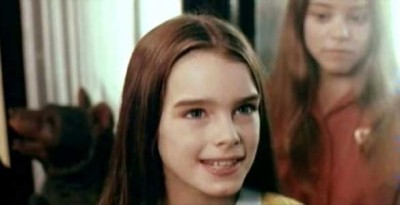
Discovered in her infancy by photographer Francesco Scavullo, the former Ivory Snow baby is best known for being the child prostitute in Pretty Baby. Just as well, since most of her other films have been rather awful, even if she did look lovely in them. Range is not an acting quality often associated with poor Brooke. Bright and athletic, Brooke has always been under the thumb of stage-mother/manager Teri Shields. Now that she’s trying to change her image, Brooke has replaced her mum with a Hollywood agency, but there are other roadblocks. “People still have trouble seeing me as an adult,” she complains. “They remember me as a teenager and they have trouble making the transition. I mean, I’m a grown woman!”
But as usual, I’ve digressed. Now then, where was I? Oh, yes – Brooke Shields is strangled in a church by a figure in a yellow raincoat and mask just prior to taking her first communion. Her jealous, mean older sister, Alice (who has been denied communion) is the logical suspect. After all, she has a yellow raincoat and mask. But her mother and her father, who has remarried, work with the young local priest to try to figure out who really is responsible. This little cult horror film is guaranteed to keep you tense. The attack scenes are not for the faint-hearted, but if you were that kind of person, you probably wouldn’t be reading this anyway.
Director Albert Sole uses the horror genre to attack Catholicism, as Alice Sweet Alice is set in the Catholic community of Paterson, New Jersey in 1961 at the beginning of the first Catholic Presidency. All the characters attend church or work in the church, yet all are sinners or were born out of sin. Significantly, the church does not help these confused, guilt-ridden, emotionally understood church members, which why a maniac (Alice?) is on a God-Told-Me-To rampage to wipe out other sinners. The Roman Catholic Church has been an inspiration for the macabre and terrifying for, well, centuries. More recently there was a revival in interest in the religious, supernatural horror film in the early to mid-2000s in a cycle that ran from Stigmata (1999) to The Exorcism Of Emily Rose (2005).
Horror rose to prominence and box office success in the seventies with a long-running series of films peppered with deeply religious themes. The church was under scrutiny in The Omen (1976), and a willing participant in the phenomenon was The Exorcist (1973). Beyond the obvious possession, the Antichrist, and exorcism-themed rip-offs, there was the unique and internationally successful Blind Dead series with its undead crusading Templar Knights. The sleazy child murders of Fulci’s Don’t Torture A Duckling (1972) also featured heavy Catholic overtones. Further back we find the church and the horrors of the Inquisition serving as inspiration for Edgar Allan Poe’s The Pit And The Pendulum. The church has even served as sanctuary for our beautiful, misunderstood monsters like The Hunchback Of Notre Dame‘s Quasimodo. With its Gothic cathedrals, supernatural rites, secret societies, and a constant lightening rod for controversy, it’s no surprise that the Roman Catholic church continues to function as a fertile breeding ground for tales of terror.
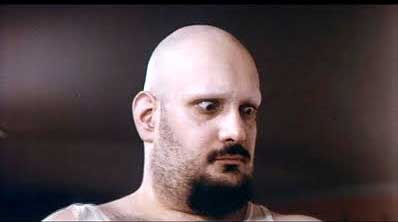 Alice Sweet Alice is full of offbeat touches and interesting characters, like the enormous Mister Alfredo. It’s a well-made film considering the budget but beware, it’s not designed for everyone’s taste. Anyway, please join me next week to have your innocence violated beyond description while I force you to submit to the horrors of…Horror News! Toodles!
Alice Sweet Alice is full of offbeat touches and interesting characters, like the enormous Mister Alfredo. It’s a well-made film considering the budget but beware, it’s not designed for everyone’s taste. Anyway, please join me next week to have your innocence violated beyond description while I force you to submit to the horrors of…Horror News! Toodles!
SPECIAL EDITION CONTENTS
Brand new 2K restoration of the theatrical version from the original camera negative
High Definition Blu-ray (1080p) presentation
Original uncompressed mono audio
Optional English subtitles for the deaf and hard of hearing
Brand new audio commentary with Richard Harland Smith
Archival audio commentary with co-writer/director Alfred Sole and editor Edward Salier
First Communion: Alfred Sole Remembers Alice, Sweet Alice – director Alfred Sole looks back on his 1976 classic
In the Name of the Father – brand new interview with actor Niles McMaster
Sweet Memories: Dante Tomaselli on Alice, Sweet Alice – filmmaker Dante Tomaselli, cousin of Alfred Sole, discusses his longtime connection to the film
Lost Childhood: The Locations of Alice, Sweet Alice – a tour of the original Alice, Sweet Alice shooting locations hosted by author Michael Gingold
Alternate Holy Terror Television Cut
Deleted scene
Alternate Opening Titles
Trailer and TV Spot
Original screenplay
Image gallery
FIRST PRESSING ONLY: COLLECTOR’S BOOKLET WITH ESSAY BY MICHAEL BLYTH
 Horror News | HNN Official Site | Horror Movies,Trailers, Reviews
Horror News | HNN Official Site | Horror Movies,Trailers, Reviews
